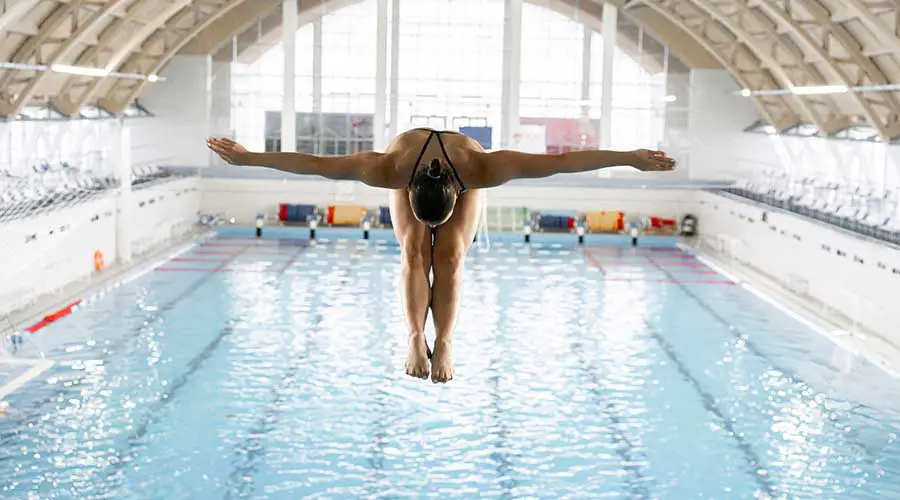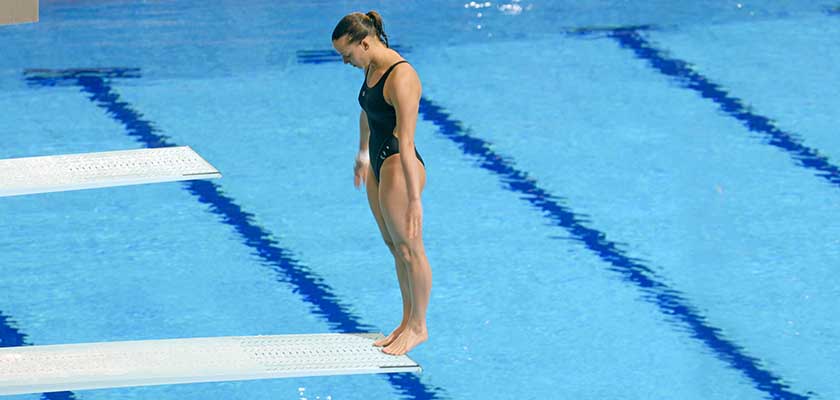Swimming and acrobatics define diving, one of the sports that demands the most effort from its athletes. The sport takes place in deep pools and depends not only on skill underwater, but also on having a lot of strength, agility and endurance.
Because it is so complex, the diving rules must be followed carefully, making competitions fair and much safer. These rules cover, for example, the different types of jumps to be analyzed, the number of attempts, clothing, timing and much more!
If you’re curious to learn more about how diving works and its rules, keep reading to find out more about the main characteristics of this sport. Get your pool ready, your swimsuit, your breath and let’s go!
Check it out 👇
Diving rules: a brief history

Before we move on to the diving rules, let’s understand a little about the history of the sport. It all began in Ancient Greece, when the inhabitants of the coastal region dived into the sea from large rocks.
It wasn’t long before the practice began to spread in Europe, especially in Germany and Sweden, becoming a very popular sport. But it was in 1904 that the sport made its debut at the Olympic Games, initially only practiced by men.
Then, in 1912, women also began to compete in diving. In Brazil, the first competition took place in 1913 in Botafogo, Rio de Janeiro. The big winner was the athlete Adolfo Wellisch.
Diving rules: how does it work?
Diving is a water sport, but part of what is assessed takes place out of the water. An athlete jumps from an elevated platform, whether fixed or not, and has to perform acrobatics until they land in the water.
The judges will assess the performance up to the moment of falling into the pool and also the way in which the dive took place. So it’s important for the athlete to be very focused on what they’re going to do, as the movement they make when they land in the water is crucial to their final score.
According to the rules of diving, the jumping platform can reach up to 10 meters, so it’s important that the athlete isn’t afraid of water or heights. As far as equipment is concerned, only the basics are used: swimming trunks or swimsuits.
Diving rules: platform and trampoline
To understand the types of jump that take place in the sport, it’s important to understand the difference between a platform and a trampoline. Platforms are nothing more than fixed ground towers that don’t move.
Trampolines, on the other hand, are boards that are not only longer but also more flexible, helping to give the athletes the boost they need. While platforms are made of concrete and need to be 10 meters away from the pool, trampolines are made of aluminum and are 1 to 3 meters away.
Diving rules: main jumping positions
According to the rules of show jumping, there are four basic positions that the athlete can take when jumping into the water: straight, stretched, grouped and free. In the carpada position, the legs must be straight and the body bent at the waist, and in the stretched position the body is straight.
In the grouped position, the details are more complex, as the athlete must jump with their knees together, glued to their chest, and with their body bent at the knees and hips. In the free position, the jumper can combine these basic positions.
Diving rules: phases of the jump
When jumping from the platform, the show jumper has five basic phases of execution. These are: approach, start, elevation, execution and entry into the water. Shall we understand how they work?
The approach phase begins when the jumper walks towards the end of the platform or trampoline, and this must be done with the correct posture and in a light, subtle way. So no running or heavy steps.
After the approach comes the start phase, which is basically the position the athlete will be in before starting the jump. Next comes the elevation phase, when the athlete needs to gain momentum to reach sufficient height to execute their jump.
In the execution phase, considered the most important when it comes to assessment, the jumper will perform their acrobatics. It’s worth remembering that these movements take place while the athlete is in the air, so they can’t make any mistakes or they’ll be badly hurt.
The last phase is the water entry, which consists of the impact between the athlete’s body and the pool. In order not to lose points, the jumper must pay attention to the right body position, spreading the least amount of water at the moment of entry.
Diving rules: jumping groups

Among the most interesting rules of diving are the jump groups, which are the names given to the movements that will be performed when jumping from the platform or trampoline to entering the water. The groups are: front, back, kick to the moon, flip or reverse, balance and screw.
Front jump: in this jump, the athlete jumps facing the pool, entering the water with their face facing the platform.
Back jump: in the back jump, the jumper performs the jump with their back to the pool, finishing with their back to the platform.
Moon kick jump: in the moon kick, the jump begins with the athlete facing the pool, and ends with them entering the water with their back to the platform.
Reverse jump: in the reverse jump, the jumper leaves with their back to the pool and enters the water with their face to the platform.
Balance jump: here, the jumper has to make a hand stop on the platform at the moment of starting. The balance jump can only be performed on platforms other than trampolines.
Screw jump: in this jump, the jumper has to make a screw movement, turning around the axis of their own body.
Show jumping rules: evaluation
When judging diving, the judges will take into account the following characteristics of the jumps: technique, beauty and style. In order to stand out from other competitors, athletes need to not only execute the jump skillfully, but also deliver movements that are beautiful to look at.
The evaluations are individual, so the judges don’t talk to each other. About 24 hours before the competition, the high jumpers must present the judging panel with what they are going to do. If they don’t comply, they get a zero.
As soon as the jump is executed, they give it a score from 0 to 10. The best and worst scores are then discarded and averaged.
What do you think about the diving rules? Did you already know about the sport? Now, take advantage of the fact that you’ve come this far to check out more information and curiosities about a wide variety of sports, and don’t forget to leave your comment!



